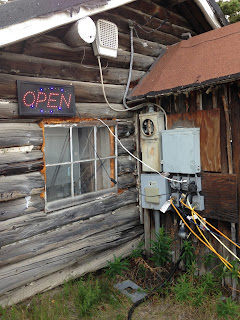 |
| Worthington Glacier |
THE SALMON ARE RUNNING!
The manager of the campground squeezed us into a site next to Kathy and Steve, a great couple from Fairbanks. The RV's were so close that if our awning was fully extended Kathy and Steve couldn't open their door. With both of us having no kids and no pets, we were perfect close neighbors.
Like umbilical cords, electrical extension cords snaked under and around RV's to supply power. We had to be careful not to trip over the wires.
Our neighbor Kathy was an avid fisherwoman and worked hard to catch her daily limit.
We had a freezer full of halibut and Kathy and Steve had a freezer full of salmon; a fish exchange was made and everybody was happy!
Before salmon roe could be used for bait, mounds of it were sprinkled with Borax and set out in the sun to dry.
LARGEST NATIONAL PARK IN THE U.S. - WRENGELL-ST. ELIAS
The fish camp was located near the largest national park in the U.S. and a perfect location for day trips to explore the surrounding area and Park. Created in 1980, and covering 13.2 million acres, Wrangell-St. Elias National Park and Preserve is equal in size to 6 Yellowstone National Parks, and is larger than the country of Switzerland. This enormous park is home to 4 major mountain ranges, 9 of the16 highest peaks in North America, and contains over 150 glaciers. The mountains are volcanic in nature, although Mount Wrangell is the only active volcano with steam escaping near the summit.
CHITNA - An almost ghost town.
 |
The town of Chitna has seen better days. |
We stopped at the visitor center, where an enthusiastic N.P. employee told us about the area and gave us an audio tour CD for our 60 mile drive to end of the road at McCarthy.
Along the Copper River in Chitna, locals were dip-netting salmon.
KENNECOTT COPPER MINE
McCarthy Highway is a gravel, washboard, potholed road that follows an abandoned railway, with bridges spanning the rivers and mountainous terrain. The railroad was built in 1911 to transport copper out of Kennecott and was abandoned when mining stopped in 1938. In the 1960's, the railroad tracks were removed and the McCarthy Highway was born.
We arrived at the end of the road, parked the car, walked across the river on a foot bridge, and boarded a shuttle van for a 6 mile ride to Kennecott, an old mining town that is a National Historic Site.
Kennecott was built on the edge of a glacier. While the glacier has shrunk about 200 feet in height over the past 80 years, the moraine covered glacial ice you see between the building and the mountain is about 300 feet thick.
Between 1911 and 1938, over 200 million dollars worth of copper was mined and processed at Kennecott.





















































